Fuzzy-Based Privacy-Preserving Scheme of Low Consumption and High Effectiveness for IoTs: A Repeated Game Model
Abstract
:1. Introduction
- Firstly, we propose a novel privacy-preserving scheme based on T-S fuzzy trust theory to mitigate the pollution attacks, in which the security is proved according to the hardness of the discrete logarithm.
- Secondly, we construct a repeated game model to formulate the optimal cluster, in which subgame-perfect Nash equilibrium is achieved, and the energy efficiency is higher than in previous research under a kind of camouflage attack.
- Finally, we prove the correctness of our privacy-preserving scheme through strict mathematical derivation and verify the performance superiority of our scheme by simulation.
2. Related Works
2.1. Privacy-Preserving Schemes
2.2. T-S Fuzzy
2.3. Game Theory
3. System Model
3.1. Network Model
3.1.1. Trust Encoding at Data
3.1.2. Trust Decoding for Receivers
3.2. Adversary Model
- Pollution attack: Attackers attempt to launch malicious data injection attacks to disrupt the data transmission. Then, data integrity and privacy are compromised.
- Camouflage attack: Attackers deceive their surrounding trust evaluation devices by pretending to be the normal devices, which leads to the wrong trust measurement results.
3.3. T-S Fuzzy Trust Model
4. The Energy-Efficient Privacy-Preserving Scheme Based on T-S Fuzzy Trust Model and Repeated Game Model
4.1. A Privacy-Preserving Scheme Based on T-S Fuzzy Trust Model
- Encrypt (h, , ). According to Definition 1, the trust set contains 0 and 1. When the trustworthiness of IoT devices is 1, the coding data will be received. Then, the source is generated as a series of t-bit binary strings . A keyed pseudo-random function is applied to generate the encryption matrixTherefore, we rewrite Equation (3) as follows,
- Sign (, , ). Suppose a full-domain hash function as a random oracle. The signature of source c is given bywhere is the signature key such that . Then, the data blocks and of the i-th generation are combined as follows:
- Verify (, , , ). When the public key , a data block , a generation , and the signature are given, the compared computation is given byandwhere o is the generator of , , and . and are two multiplicative cyclic groups, which satisfy in a bilinear map, and . When , the verification is successful; otherwise, it fails.
- Decrypt (h, , ). When the secret key k and the pseudo-random function f are given, the decryption matrix can be computed as follows:
4.2. The Correctness and Security Analysis of Our Privacy-Preserving Sheme
4.3. The Optimization Cluster Formulation Scheme Based on Repeated Game Model
4.3.1. Repeated Game Model
- (a)
- Attackers and defenders are the cooperating parties in the repeated game, where .
- (b)
- Given the utility function and , and the loss discount , the average utility is and , where r is number of iterations according to the lifetime of the network. Furthermore, the total payoff for both parties are respectively as follows:where the weight of the current and future payoff is inconsistent, and the future payoff is generally less than the weight of the current payoff.
- (c)
- The proposed repeated game model is finite due to the power of the entire network being predetermined. Therefore, the finite repeated game can be solved by the backward method, which basically converges to the sub-game equilibrium.
4.3.2. The Solution of Repeated Game Model for Optimizing Cluster Formulation
- (a)
- Suppose that all members of and IoT devices become CH with no CM, and the payoffs of defender and attacker are decreasing. At this time, the cluster is illegal. Therefore, the utility of defender and attacker in the iteration r can be expressed aswhere and are the weights of the reward and penalty, , . and are the trustworthiness of low-energy and high-energy IoT devices. Meanwhile, and are the communication costs of high-energy and low-energy IoT devices.
- (b)
- Suppose that and IoT devices respectively become CH and CM; the payoff of the defender is the highest, and that of the attacker is the lowest. Therefore, the utility of the defender and attacker in the iteration r can be expressed as
- (c)
- Suppose that and IoT devices respectively become CH and CM, and the payoffs of the attacker are the highest. However, the CH with can also help the network controller formulate a legal cluster. Therefore, the weight of reward and penalty are predefined, and the utility of defender and attacker in the iteration r are given by
- (d)
- Suppose that and IoT devices have become CM with no CH; then, the cluster is illicit. Therefore, the respective utilities of the defender and attacker in the iteration r are given by
5. Simulation Result and Discussion
5.1. Simulation Parameter Setting
- (a)
- The trustworthiness of each IoT device consists of direct trust and indirect trust . The total trust is defined as follows:where and are the weight parameters of direct and indirect trust, which satisfy . The trust evaluation method including direct and indirect trust can be found in [39].
- (b)
- (c)
- The lifetime of the IoT reflects lower resource consumption than in other literature. Furthermore, the lifetime of IoTs with our repeated game model is the highest.
5.2. Performance Comparison
- (a)
- Energy Efficiency with T-S Fuzzy Trust Model: In Figure 2 and Figure 3, the energy consumption of our T-S fuzzy trust model is compared with NCS0-, NCS1-, and ID-based schemes. The result of the simulation shows that our scheme has the lowest energy consumption. As the number of attack nodes in the IoT increases, the energy required for trust evaluation gradually increases. However, the energy consumption of our scheme has been in a stable state, and there is no significant increase. Meanwhile, our scheme has the highest remaining energy than other schemes when the [30–100].
- (b)
- Time Efficiency of Our Privacy-Preserving Scheme: In Figure 4, the runtime of our trust-based privacy-preserving scheme is the lowest compared to the other three methods. In addition, our scheme has higher stability according to the magnitude of running time variation.
- (c)
- Time Consumption with Cluster Formulation: In Figure 5 and Figure 6, we compare the time consumption when the hop limit is 1 and 2 under camouflage attack. Based on theoretically verifying that the proposed repeated game has effective game equilibrium, we also find our game-based cluster formulation has the lowest time consumption.
6. Conclusions
Author Contributions
Funding
Institutional Review Board Statement
Informed Consent Statement
Data Availability Statement
Conflicts of Interest
Appendix A
Appendix A.1. The Optimizing Solution of Defenders
Appendix A.2. The Optimizing Solution of Attackers
References
- Noor, M.B.M.; Hassan, W.H. Current research on Internet of Things (IoT) security: A survey. Comput. Netw. 2018, 148, 283–294. [Google Scholar] [CrossRef]
- Rani, R.; Kumar, S.; Dohare, U. Trust Evaluation for Light Weight Security in Sensor Enabled Internet of Things: Game Theory Oriented Approach. IEEE Internet Things J. 2019, 6, 8421–8432. [Google Scholar] [CrossRef]
- Wu, Y.; Kang, B.; Wu, H. Strategies of attack–defense game for wireless sensor networks considering the effect of confidence level in fuzzy environment. Eng. Appl. Artif. Intell. 2021, 102, 104238. [Google Scholar] [CrossRef]
- Hou, J.; Qiao, J.; Han, X. Energy-Saving Clustering Routing Protocol for Wireless Sensor Networks Using Fuzzy Inference. IEEE Sens. J. 2022, 22, 2845–2857. [Google Scholar] [CrossRef]
- Kumar, S.; Goswami, A.; Gupta, R.; Singh, S.P.; Lay-Ekuakille, A. A Game-Theoretic Approach for Cost-Effective Multicast Routing in the Internet of Things. IEEE Internet Things J. 2022. [Google Scholar] [CrossRef]
- Adil, M.; Khan, R.; Almaiah, M.A.; Binsawad, M.; Ali, J.; Saaidah, A.A.; Ta, Q.T.H. An Efficient Load Balancing Scheme of Energy Gauge Nodes to Maximize the Lifespan of Constraint Oriented Networks. IEEE Access 2020, 8, 148510–148527. [Google Scholar] [CrossRef]
- Zhang, P.; Wang, Y.; Kumar, N.; Jiang, C.; Shi, G. A Security and Privacy-Preserving Approach Based on Data Disturbance for Collaborative Edge Computing in Social IoT Systems. IEEE Trans. Comput. Soc. Syst. 2021, 9, 97–108. [Google Scholar] [CrossRef]
- Zhao, F.; Kalker, T.; Medard, M.; Han, K.J. Signatures for Content Distribution with Network Coding. In Proceedings of the 2006 40th Annual Conference on Information Sciences and Systems, Princeton, NJ, USA, 22–24 March 2006. [Google Scholar]
- Peng, Z.; Jiang, Y.; Lin, C.; Yao, H.; Shen, X. Padding for orthogonality: Efficient subspace authentication for network coding. In Proceedings of the Infocom, Shanghai, China, 10–15 April 2011. [Google Scholar]
- Guangjun, L.; Bin, W. Secure network coding against intra/inter-generation pollution attacks. China Commun. 2013, 10, 100–110. [Google Scholar] [CrossRef]
- Li, Y.; Yao, H.; Chen, M.; Jaggi, S.; Rosen, A. RIPPLE Authentication for Network Coding. In Proceedings of the 2010 Proceedings IEEE INFOCOM, San Diego, CA, USA, 14–19 March 2010; pp. 1–9. [Google Scholar] [CrossRef]
- Cheng, C.; Jiang, T. An Efficient Homomorphic MAC with Small Key Size for Authentication in Network Coding. IEEE Trans. Comput. 2013, 62, 2096–2100. [Google Scholar] [CrossRef]
- Cheng, C.; Lee, J.; Jiang, T.; Takagi, T. Security Analysis and Improvements on Two Homomorphic Authentication Schemes for Network Coding. IEEE Trans. Inf. Forensics Secur. 2016, 11, 993–1002. [Google Scholar] [CrossRef]
- Li, T.; Chen, W.; Tang, Y.; Yan, H. A Homomorphic Network Coding Signature Scheme for Multiple Sources and its Application in IoT. Secur. Commun. Netw. 2018, 2018, 9641273. [Google Scholar] [CrossRef]
- Fiandrotti, A.; Gaeta, R.; Grangetto, M. Simple Countermeasures to Mitigate the Effect of Pollution Attack in Network Coding-Based Peer-to-Peer Live Streaming. IEEE Trans. Multimed. 2015, 17, 562–573. [Google Scholar] [CrossRef] [Green Version]
- Antonopoulos, A.; Verikoukis, C. COPS: Cooperative Statistical Misbehavior Mitigation in Network-Coding-aided Wireless Networks. IEEE Trans. Ind. Inform. 2017, 14, 1436–1446. [Google Scholar] [CrossRef]
- Lawrence, T.; Li, F.; Ali, I.; Kpiebaareh, M.Y.; Christopher, T. An HMAC-based authentication scheme for network coding with support for error correction and rogue node identification. J. Syst. Archit. 2021, 116, 102051. [Google Scholar] [CrossRef]
- Sodhro, A.H.; Sennersten, C.; Ahmad, A. Towards Cognitive Authentication for Smart Healthcare Applications. Sensors 2022, 22, 2101. [Google Scholar] [CrossRef]
- Li, X.J.; Yan, J.J.; Yang, G.H. Adaptive Fault Estimation for T-S Fuzzy Interconnected Systems Based on Persistent Excitation Condition via Reference Signals. IEEE Trans. Cybern. 2018, 49, 2822–2834. [Google Scholar] [CrossRef]
- Rajeswari, A.R.; Kulothungan, K.; Ganapathy, S.; Kannan, A. Trusted energy aware cluster based routing using fuzzy logic for WSN in IoT. J. Intell. Fuzzy Syst. 2021, 40, 9197–9211. [Google Scholar] [CrossRef]
- Cao, K.-R.; Liu, J.-Q.; Huang, X.-L.; Gao, X.-Z.; Ban, X.-J. Stability Analysis of T–S Fuzzy Control Systems by Using Set Theory. J. Harbin Inst. Technol. 2012, 19, 7–11. [Google Scholar]
- Han, J.; Zhang, H.; Wang, Y.; Zhang, K. Fault Estimation and Fault-Tolerant Control for Switched Fuzzy Stochastic Systems. IEEE Trans. Fuzzy Syst. 2018, 26, 2993–3003. [Google Scholar] [CrossRef]
- Dong, J.; Wu, Y.; Yang, G.H. A New Sensor Fault Isolation Method for T–S Fuzzy Systems. IEEE Trans. Cybern. 2017, 47, 2437–2447. [Google Scholar] [CrossRef]
- Liu, M.; Cao, X.; Shi, P. Fuzzy-model-based fault-tolerant design for nonlinear stochastic systems against simultaneous sensor and actuator faults. IEEE Trans. Fuzzy Syst. 2012, 21, 789–799. [Google Scholar] [CrossRef]
- Liu, J.; Wei, L.; Xie, X.; Tian, E.; Fei, S. Quantized Stabilization for T–S Fuzzy Systems With Hybrid-Triggered Mechanism and Stochastic Cyber-Attacks. IEEE Trans. Fuzzy Syst. 2018, 26, 3820–3834. [Google Scholar] [CrossRef]
- Zhang, Z.; Niu, Y.; Song, J. Input-to-State Stabilization of Interval Type-2 Fuzzy Systems Subject to Cyberattacks: An Observer-Based Adaptive Sliding Mode Approach. IEEE Trans. Fuzzy Syst. 2019, 28, 190–203. [Google Scholar] [CrossRef]
- Yan, J.J.; Yang, G.H.; Li, X.J. Fault detection in finite frequency domain for T-S fuzzy systems with partly unmeasurable premise variables. Fuzzy Sets Syst. 2020, 421, 158–177. [Google Scholar] [CrossRef]
- Mohamed, A.; Karim, S.; Maha, E.; Osamu, M.; Hiroshi, F.; Adel, A.R. Game Theory Meets Wireless Sensor Networks Security Requirements and Threats Mitigation: A Survey. Sensors 2016, 16, 1003. [Google Scholar]
- Riahi Sfar, A.; Challal, Y.; Moyal, P.; Natalizio, E. A Game Theoretic Approach for Privacy Preserving Model in IoT-Based Transportation. IEEE Trans. Intell. Transp. Syst. 2019, 20, 4405–4414. [Google Scholar] [CrossRef]
- Abdalzaher, M.S.; Seddik, K.; Muta, O.; Mohamed. Using Stackelberg game to enhance cognitive radio sensor networks security. IET Commun. 2017, 11, 1503–1511. [Google Scholar] [CrossRef]
- Abdalzaher, M.S.; Seddik, K.; Muta, O. An effective Stackelberg game for high-assurance of data trustworthiness in WSNs. In Proceedings of the 2017 IEEE Symposium on Computers and Communications (ISCC), Heraklion, Greece, 3–6 July 2017. [Google Scholar]
- Abdalzaher, M.S.; Seddik, K.; Muta, O. Using repeated game for maximizing high priority data trustworthiness in Wireless Sensor Networks. In Proceedings of the 2017 IEEE Symposium on Computers and Communications (ISCC), Heraklion, Greece, 3–6 July 2017. [Google Scholar]
- Duan, J.; Gao, D.; Yang, D.; Foh, C.H.; Chen, H.H. An Energy-Aware Trust Derivation Scheme With Game Theoretic Approach in Wireless Sensor Networks for IoT Applications. Internet Things J. 2014, 1, 58–69. [Google Scholar] [CrossRef]
- Li, Y.; Shi, L.; Chen, T. Detection against linear deception attacks on multi-sensor remote state estimation. IEEE Trans. Control. Netw. Syst. 2017, 5, 846–856. [Google Scholar] [CrossRef]
- Yan, S.; Peng, M.; Cao, X. A Game Theory Approach for Joint Access Selection and Resource Allocation in UAV Assisted IoT Communication Networks. IEEE Internet Things J. 2019, 6, 1663–1674. [Google Scholar] [CrossRef]
- Liu, X.; Huang, J.; Wu, Y.; Zong, G. A privacy-preserving signature scheme for network coding. IEEE Access 2019, 7, 109739–109750. [Google Scholar] [CrossRef]
- Yan, K.; Wang, S.; Wang, S.; Liu, C. Hybrid intrusion detection system for enhancing the security of a cluster-based wireless sensor network. In Proceedings of the 2010 3rd International Conference on Computer Science and Information Technology, Chengdu, China, 9–11 July 2010; Volume 1, pp. 114–118. [Google Scholar]
- Sedjelmaci, H.; Senouci, S.M.; Taleb, T. An accurate security game for low-resource IoT devices. IEEE Trans. Veh. Technol. 2017, 66, 9381–9393. [Google Scholar] [CrossRef]
- Qi, C.; Huang, J.; Wang, B.; Wang, H. A Novel Privacy-Preserving Mobile-Coverage Scheme Based on Trustworthiness in HWSNs. Wirel. Commun. Mob. Comput. 2021, 2021, 9935780. [Google Scholar] [CrossRef]
- Boneh, D.; Freeman, D.; Katz, J.; Waters, B. Signing a linear subspace: Signature schemes for network coding. In Proceedings of the International Workshop on Public Key Cryptography, Irvine, CA, USA, 18–20 March 2009; pp. 68–87. [Google Scholar]
- Lin, Q.; Yan, H.; Huang, Z.; Chen, W.; Shen, J.; Tang, Y. An ID-based linearly homomorphic signature scheme and its application in blockchain. IEEE Access 2018, 6, 20632–20640. [Google Scholar] [CrossRef]
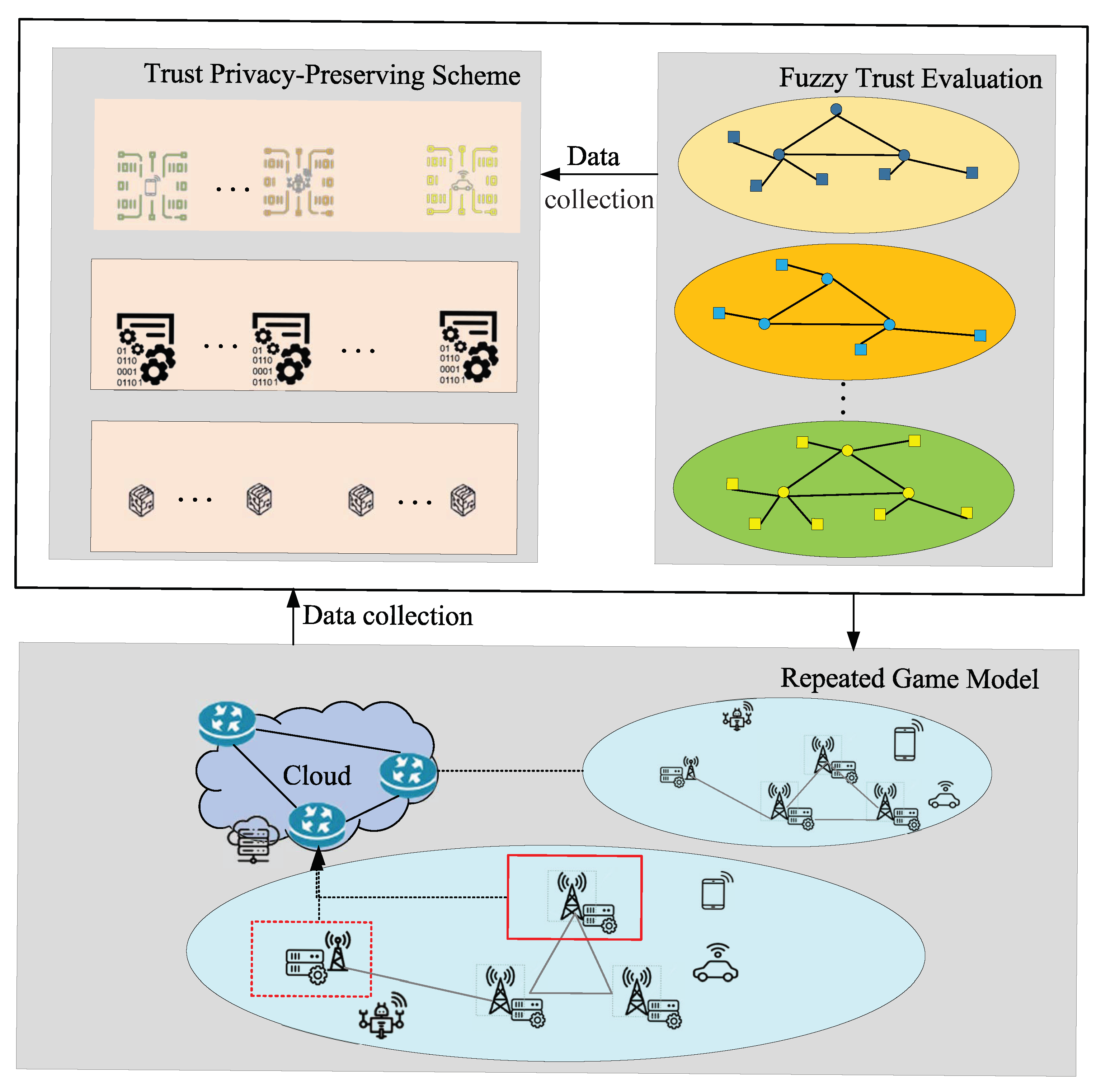
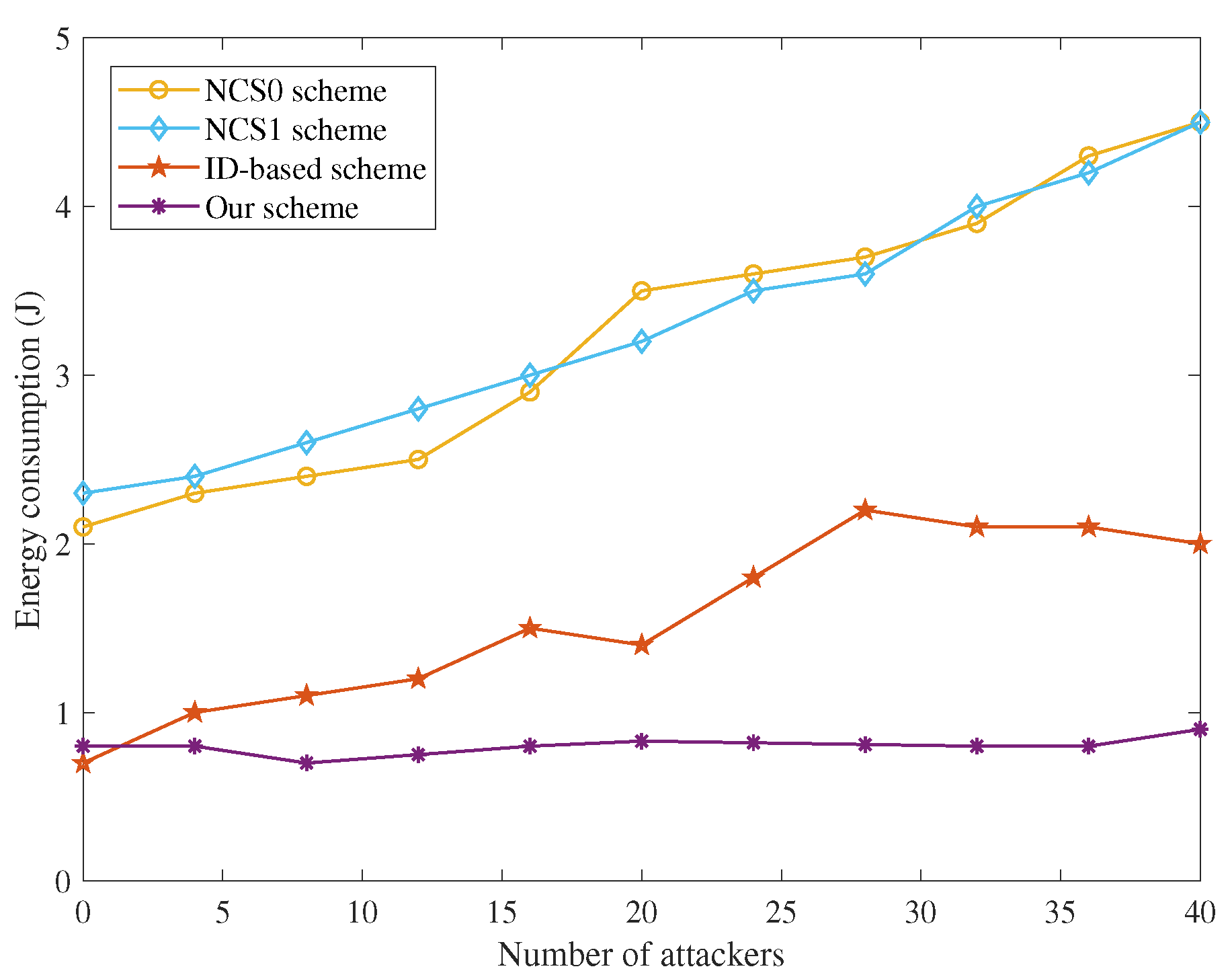
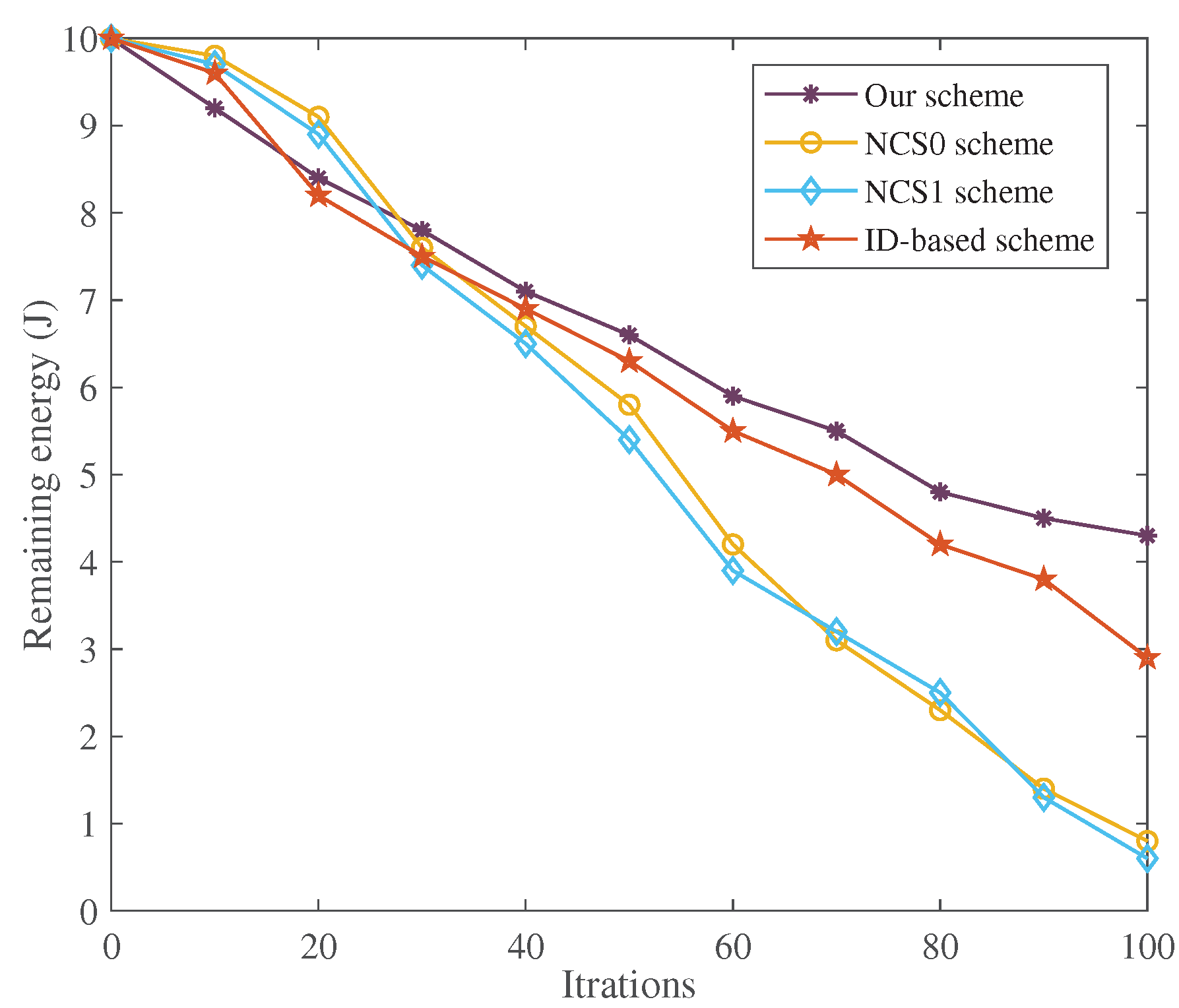
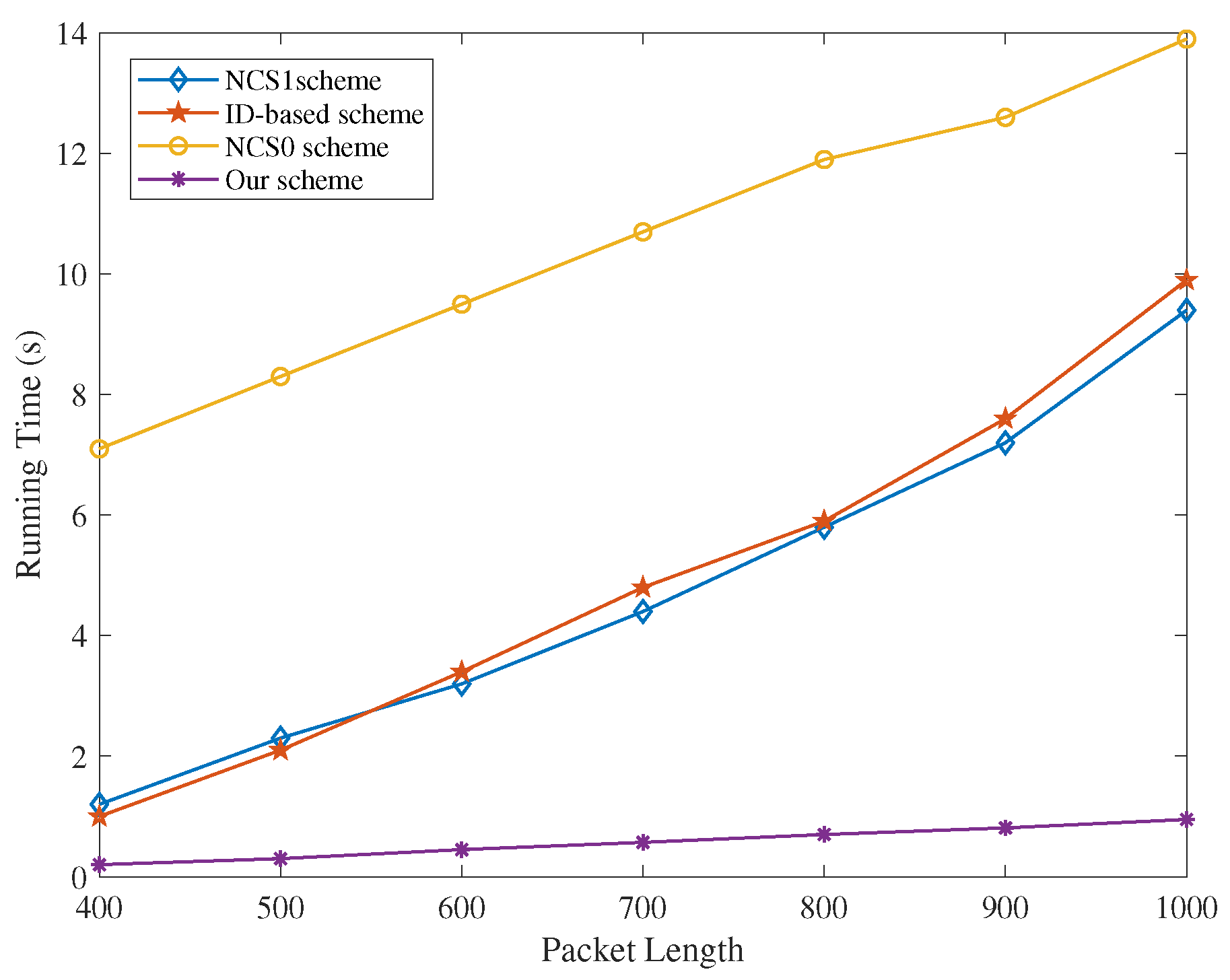
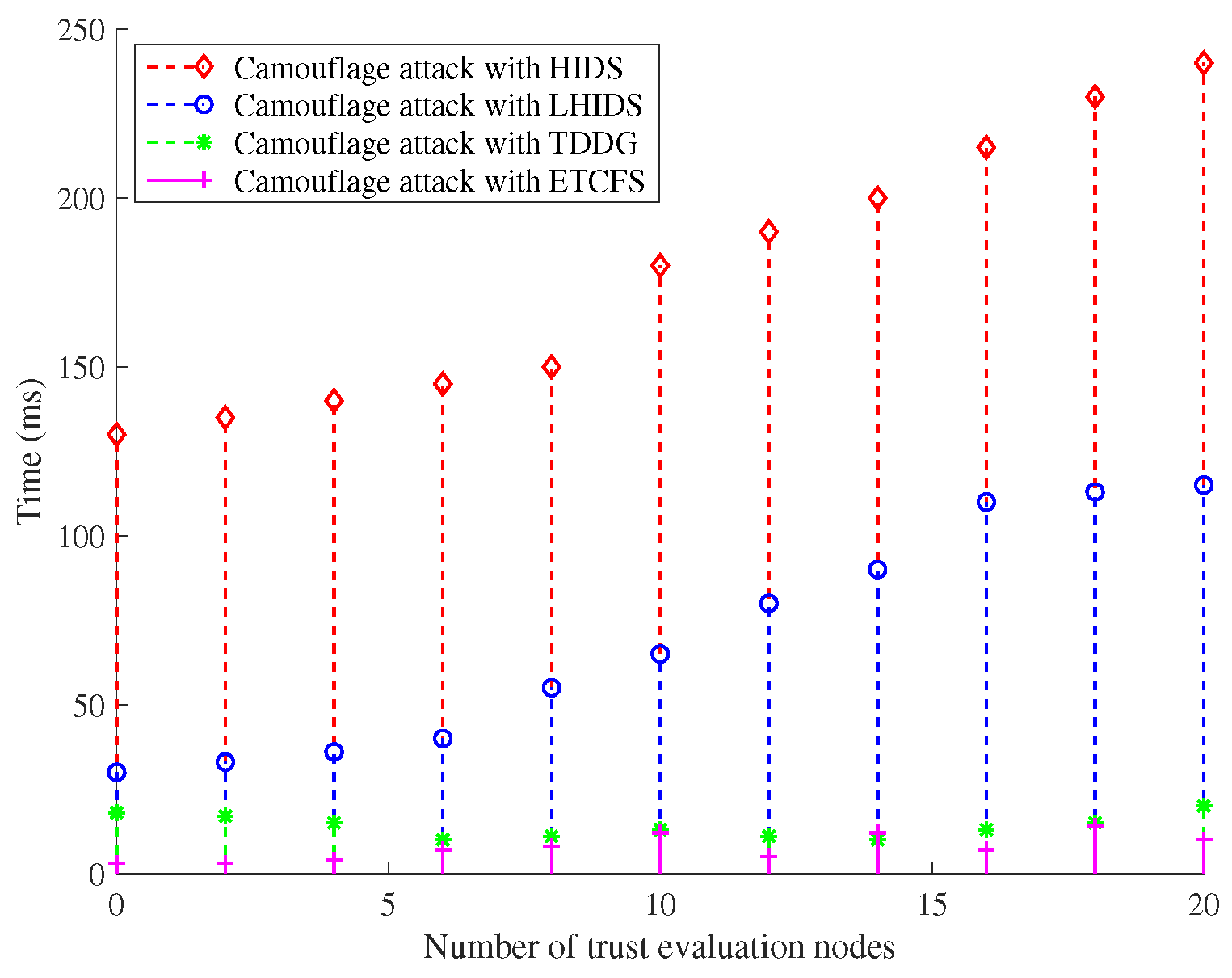
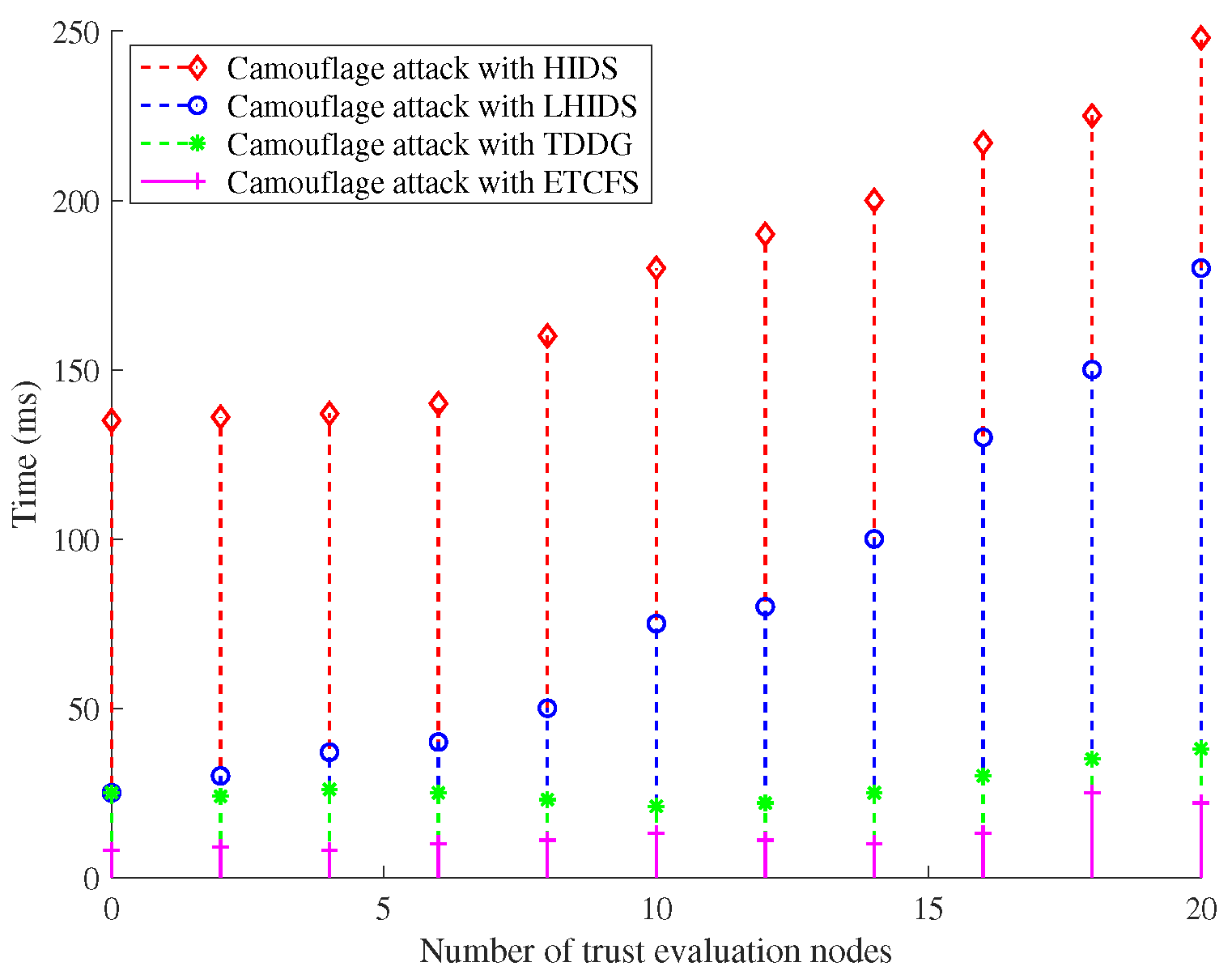
| Strategy | To Be CH | To Be CM |
|---|---|---|
| Normal | , | , |
| Malicious | , | , |
| Parameter | Value | Parameter | Value |
|---|---|---|---|
| Network region | 200 × 200 m | Communication radius | 2 m |
| Number of IoT devices | 100 | Sensing radius | 1 m |
| Initial trustworthiness | 0.6 | Attack intensity | 0.2–0.6 |
| Packet length | 400–1000 | 0.2, 0.2, 0.4 | |
| Initial energy | 10 J | Maximum iteration | 100 |
| Eth | 4 J | Hop limit | 2 |
Publisher’s Note: MDPI stays neutral with regard to jurisdictional claims in published maps and institutional affiliations. |
© 2022 by the authors. Licensee MDPI, Basel, Switzerland. This article is an open access article distributed under the terms and conditions of the Creative Commons Attribution (CC BY) license (https://creativecommons.org/licenses/by/4.0/).
Share and Cite
Cao, L.; Zhu, M. Fuzzy-Based Privacy-Preserving Scheme of Low Consumption and High Effectiveness for IoTs: A Repeated Game Model. Sensors 2022, 22, 5674. https://doi.org/10.3390/s22155674
Cao L, Zhu M. Fuzzy-Based Privacy-Preserving Scheme of Low Consumption and High Effectiveness for IoTs: A Repeated Game Model. Sensors. 2022; 22(15):5674. https://doi.org/10.3390/s22155674
Chicago/Turabian StyleCao, Laicheng, and Min Zhu. 2022. "Fuzzy-Based Privacy-Preserving Scheme of Low Consumption and High Effectiveness for IoTs: A Repeated Game Model" Sensors 22, no. 15: 5674. https://doi.org/10.3390/s22155674
APA StyleCao, L., & Zhu, M. (2022). Fuzzy-Based Privacy-Preserving Scheme of Low Consumption and High Effectiveness for IoTs: A Repeated Game Model. Sensors, 22(15), 5674. https://doi.org/10.3390/s22155674






